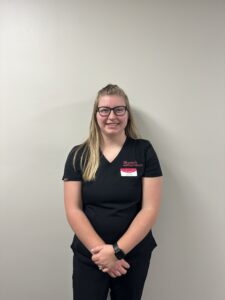I knew I wanted to work in healthcare all through high school. I had been thinking of going into imaging, and job shadowed in general ultrasound (more of the abdominal and vascular areas of the body) to see what it was all about. I loved that as an ultrasound tech, you get more one-on-one time with patients and can often make a personal connection and real impact on their care. While going through school, we learn so much about different areas of the body and the variety of ways ultrasound may be used to determine health and well-being. I was fascinated by the use of ultrasound, not only in obstetrics but also in gynecology. I knew that OB/GYN was where I wanted to be in my career as a Sonographer.
I originally started at Women’s Health Specialists only working with Family Fertility, before I became a full-time tech at our St. Elizabeth Clinic. Ultrasound is often used for women as they encounter problems with their periods, pains in their pelvis, and issues with their cycles. Fertility and infertility are often included in these concerns. WHS provides a unique opportunity to me as a sonographer, because we are one of the few clinics in the Fox Valley area that provide monitoring and care for patients going through the incredibly difficult journey of infertility. I get to work with patients who are going through the process of family planning, whether that is through timing their cycles, Intrauterine Insemination (IUI), or In Vitro Fertilization (IVF). Our amazing nurses with Family Fertility help our patients with planning their route of care, specific to each individual. Once that is determined, patients are monitored by lab work and ultrasound imaging to determine when they are at the best point in their cycle to achieve pregnancy. When we monitor with ultrasound, we scan transvaginally to look at the uterus and endometrial lining, where implantation of a pregnancy should occur; and at the ovaries, to determine how many follicles (which hold the egg) there are and how they appear to be growing/maturing. Our physicians and the nurses with Family Fertility use this information to track when an insemination should occur, at the peak of the cycle. They also work closely with Endocrinologists and Fertility Specialists across the country (and sometimes the world) to determine when an egg retrieval or embryo transfer will be done, timing these to achieve the greatest success.
Once our Family Fertility patients get a positive pregnancy test, we will usually do labs and at least one early ultrasound around 6-7 weeks to see how many babies there are and measure them to ensure that they are growing appropriately. After that, some patients move on from WHS back to their regular clinic for care through the rest of their pregnancy. However, it is so special to scan the mothers that stay with WHS, who we have gotten to know through their process of becoming pregnant, all the way through their pregnancy, getting to show them their baby’s heart beating, hearing how they told their families of their pregnancy, finding out the gender, and wishing them luck in their delivery. The process of becoming pregnant isn’t always an easy one, but it is one that WHS and Family Fertility can help with if the need arises.